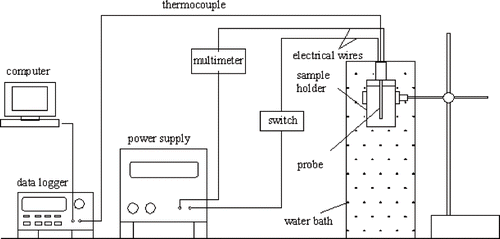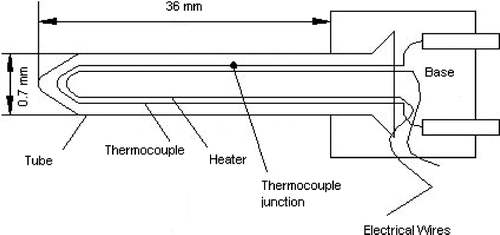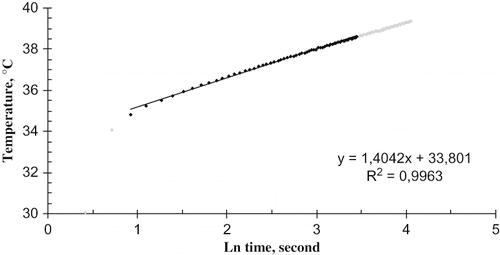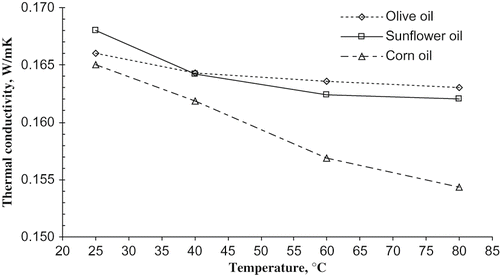Abstract
Thermal conductivities of three different edible oils, namely sunflower oil, corn oil and olive oil, were measured at temperatures 25, 40, 60, and 80°C. The measurements were carried out using a hot wire probe method. The calibration of the probe was performed using 0.3% agar gel with water and glycerin. In general, thermal conductivities of oils used in this study are found to be decreasing with temperature. The values of thermal conductivity measured are quite near to each other, the highest and the lowest being respectively 0.168 W/m K for sunflower oil at 25°C and 0.152 W/m K for corn oil at 80°C.
INTRODUCTION
Thermal conductivity and diffusivity of food materials are important properties for understanding the transport processes during food processing such as heating, cooling, frying, and drying. Reviews of food thermal conductivity measurements have been made by many authors, such as Woodams et al.,[Citation1] Qashou et al.,[Citation2] Krokida et al.[Citation3] However, in most of these investigations the compositions of the measured samples were not fully specified and the thermal conductivity data found in the literature showed some variation due to the variations of composition and structure for the same material. The effect of thermal conductivity measuring method and conditions of measurement might be another factor for the difference in thermal conductivity values. As the steady state methods takes longer times for measurements than the transient methods, the properties of the samples might be altered during the measurements such as loss of moisture at the end of the measurement. In general, thermal conductivity depends strongly on moisture content, temperature, structure and orientation of the material.[Citation4]
Thermal conductivities of some oil are listed in ASHRAE Handbook of Fundamentals[Citation5] at different temperatures; the values of thermal conductivity range between 0.156 W/m K for nutmeg oil at 4°C to 0.176 W/m K for almond oil at 4°C. Whereas, in the same handbook, the values of thermal conductivities for olive oil were given from two different sources at various temperatures: from the first source, a single value of 0.176 W/m K was given by Weber at 7°C [Citation6]; and from the second source by Kaye and Higgins[Citation7] the thermal conductivities were given as 0.168, 0.166, 0.160, 0.156 W/m K, respectively, at temperatures of 32, 65, 151, 185°C. In another publication,[Citation8] thermal conductivity of olive oil was given at three different temperatures as 0.170, 0.166, 0.163 W/m K, respectively, at 29, 49, 100°C.
In a collaborative study,[Citation9] organized within the framework of COST Action 93, some typical food materials including olive oil were bought from one source, samples divided were shipped to 6 participating laboratories which were asked to start the thermal conductivity measurements immediately after receipt of the materials. The experimental obtained by the participating laboratories varied considerably but they all showed an increase in thermal conductivity with increase in temperature except for olive oil which showed a decrease with thermal conductivity values ranging between 0.15 to 0.17 W/m K for temperatures 50, 100, and 135°C. These results have demonstrated that it is rather difficult to come up with reliable accurate information about the thermal conductivity of food materials. Problems may be related to the measuring procedures, in particular the variability in contact resistances between heat source, thermal sensor and test materials.
There have been many attempts[Citation10–12] for developing structural models to predict the thermal conductivity of foods. In a more recent publication, Carson[Citation13] reviewed effective thermal conductivity models for foods, he concluded that almost all the models proposed are highly specific to a particular material and contains material-specific parameters; while other models have more general applicability, but may still contain parameters whose values must be determined empirically. He also emphasized that it is highly unusual to find measured thermal conductivity data having reported uncertainties of less than ± 2% due to the inherent biological variation of food products, the typical uncertainty figures are ± 3 to ± 5% usually.
MATERIALS AND METHODS
Material
Three types of oil are considered in this study olive oil (Riviera type), sunflower oil and corn oil, their properties such as free fatty acid content, peroxide value, iodine value, and density are given in the and . All of the samples used for this study were obtained from an oil processing plant in Izmir, Turkey.
Table 1 Properties of samples
Table 2 Fatty acid composition of samples (%)
Calibration Materials
The experimental apparatus was calibrated with 0.3% agar gel and glycerin. The average thermal conductivities value for agar gel and glycerin were measured as 0.625 W/m K and 0.290 W/m K, respectively at 30°C which differed only 1.4% from the literature[Citation14] value of 0.616 W/m K for water and 0.286W/m K for glycerin.
Method
Theory of thermal conductivity measurement by a hot wire probe
The hot wire probe method has been used to measure thermal conductivity of biological materials, insulations, rocks, ceramics, foods, soils, and glass over a wide range of temperatures and other environmental conditions. Briefly stated, a line source (probe or heated wire) is inserted into a sample initially at uniform and constant temperature, T0. Constant power is then supplied to the line heater element starting at time, t = 0, and the temperature adjacent to the line heat source is recorded with respect to time during a short heating interval. This method measures thermal conductivity, assuming transient heat conduction from an infinitely long line heat source immersed in an infinite and homogenous medium and is expressed by the following Fourier equation:
Subject to the following initial condition and boundary conditions:
where r is the radial distance in meters; α(m2/s) is the thermal diffusivity; k(W/m K) is the thermal conductivity; and Q (W/m) is the heat dissipated per unit length and per unit time of the resistor wire line heat source. For values of time (t seconds) that satisfy t >> r2/4α, the approximate solution of EquationEq. (1) is given by the temperature rise at the surface of the line heat source at r = r0, as:
where, C = eγ = 1.781 is the exponential of Euler's constant. Considering thermal diffusivity constant in the small temperature range of the measurements, the thermal conductivity can be determined by differentiating ΔT with respect to ln(t):
The thermal conductivity can therefore be determined from the power input to the resistance wire per unit length of the probe and the slope “S” of the straight line portion of the plot of ΔT with respect to ln(t):
Measurement Apparatus
The apparatus used in this work was based on the system described by Sweat and Haugh[Citation15] shown in . The cross section of the line heat source probe was shown in . The probe had a tube made from stainless steel hypodermic needle 0.7 mm in diameter and 36 mm in length with a length to diameter ratio of 51. The line heat source consisted of a constantan wire of 0.0762-mm diameter coated with 0.076 mm thickness of teflon, its electrical resistance was 223 Ω/m and remained constant over the experimental temperature ranges used in this study. Its temperature coefficient was two orders of magnitude lower than that of platinum wire. The chrome-constantan thermocouple had 0.05-mm diameter and electrically insulated from the heater wire by the teflon coating. The sample holder consisting of a cylindrical plastic tube had 3-cm diameter and 5-cm length, and its temperature was controlled by a water bath of 65 liters in volume. The constant DC current for the heater wire was supplied by means of a 0–30 volt range D.C. power supply (Goodwill GPC-3030D), a switch was used to start the heating. The accuracy of the current measurement in the heater was ±1 mA. The temperature values were recorded with respect to time by a data logger (HP34970A, 0.1°C resolution). The measurement of temperature rise with respect to time took 30 seconds with a reading each 0.5 second.
The power input used was 5.01 W/m for all experiments. shows the ln(t)-T(°C) curve for calibration material glycerin. If we use the slope of the fitted line (to the curve by the linear regression analyses) in EquationEq. (7):
The thermal conductivity was calculated as “k” = 0.284 W/m K.
RESULTS AND DISCUSSION
The results of thermal conductivity measurements for olive oil, sunflower oil, and corn oil are given in . For each sample, thermal conductivity measurements were repeated 8 times, the average values are calculated and the standard deviation is in the order of 0.005 W/m K. From , it can be seen that thermal conductivities decreased from 25°C to 80°C; for olive oil this decrease was from 0.166 to 0.163 W/m K, for sunflower oil the decrease was from 0.168 to 0.162 W/m K. and for corn oil the decrease was from 0.167 W/m K to 0.153 W/m K. The thermal conductivity values of the oils in this study were found to be similar with previous results from the literature, the difference being less than 3%. Moreover, the decrease of thermal conductivity with increasing temperature determined in this experimental work corresponded with previous measurements.[Citation7,Citation8]
CONCLUSION
The thermal conductivities of sunflower oil, corn oil and olive oil were measured at temperatures 25, 40, 60, and 80°C. In this study, the properties such as free fatty acid content, peroxide value, colour, iodine value, density, fatty acid compositions, of all oil samples were also determined. As most of the previous work, hot wire probe method was used to measure thermal conductivity, the experimental values for thermal conductivity of olive oil was similar to those measured by different previous researchers, the decrease in thermal conductivity is very small with increasing temperature. The decrease in thermal conductivities with temperature was more important for the corn oil compared to other oils.
NOMENCLATURE
| C | = |
Exponential of Euler's constant |
| I | = |
Electric current (A) |
| Q | = |
Heat dissipated per unit length, per unit time (W/m) |
| k | = |
Thermal conductivity (W/m K) |
| r | = |
Radial cylindrical radius (m) |
| T | = |
Temperature (°C) |
| T0 | = |
Initial temperature (°C) |
| t | = |
time (s) |
| S | = |
Slope of temperature versus ln(t) |
| α | = |
Thermal diffusivity (m2/s) |
REFERENCES
- Woodams , E.E. and Nowrey , J.E. 1968 . Literature Values of Thermal Conductivities of Foods . Food Technology , 22 : 494 – 502 .
- Qashou , M.S. , Vacon , R.I. and Touloukian , Y.S. 1972 . Thermal Conductivity of Foods . ASHRAE Transactions , 78 : 165 – 183 .
- Krokida , M.K. , Panagiotou , N.M. , Maroulis , Z.B. and Saravacos , G.D. 2001 . Thermal Conductivity Prediction for Foodstuffs: Effect of Moisture Content and Temperature . International Journal of Food Properties , 4 ( 1 ) : 111 – 137 .
- Rahman , M.S. , Chen , X.D. and Perera , C.O. 1997 . An improved thermal conductivity prediction model of fruits and vegetables as a function of temperature, water content and porosity . Journal of Food Engineering , 31 ( 2 ) : 163 – 170 .
- ASHRAE . 1981 . Handbook of Fundamentals , Vol. 31 , 1 – 21 . Atlanta, GA : ASHRAE .
- Weber , H.F. 1880 . Untersuchungen Uber die Warmeleitung in Flüssigkeiten . Annelen der Physik , 10 ( 3 ) : 304
- Kaye , G. W.C. and Higgins , W.F. 1928 . The Thermal Conductivities of Certain Liquids . Proceeding of Royal Society of London , A117 : 459
- Woolf , J.R. and Sibbitt , W.L. 1954 . Thermal Conductivity of Liquids . Industrial & Engineering Chemistry , 46 : 1947
- Spiess , W.E.L. , Walz , E. , Nesvadba , P. , Morley , M. , van Haneghem , I.A. and Salmon , D.R. 2001 . Thermal Conductivity of Food Materials at Elevated Temperatures . High Temperatures High Pressures , 33 ( 6 ) : 693 – 697 .
- Thorne , S. 1992 . Mathematical Modeling of Food Processing Operations , London : Elsevier Applied Science .
- Rahman , M. S. 1995 . Food Properties Handbook , London, , UK : CRC Press .
- Marinos-Kouris , D. and Maroulis , Z.B. 1995 . “ Transport Properties in the Drying of Solids ” . In Handbook of Industrial Drying , Edited by: Mujumdar , A. 35 – 50 . New York : Marcel Decker Inc .
- Carson , J.K. 2006 . Review of Effective Thermal Conductivity Models for Foods . International Journal of Refrigeration , 29 ( 6 ) : 958 – 967 .
- Incropera , F.P. and De Witt , D.P. 1996 . Fundamentals of Heat and Mass Transfer , New York : John Wiley & Sons .
- Sweat , V.E. and Haugh , C.G. 1974 . A Thermal Conductivity Probe for Small Food Samples . Transactions of ASAE , 17 : 56 – 58 .



